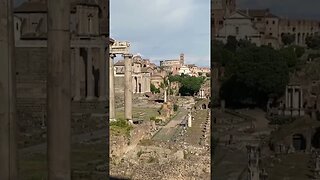Premium Only Content

The Rise and Fall of the Mighty Roman Empire: A Historical Journey
The Roman Empire is one of the most influential empires in human history. It spanned over three continents and lasted for over five centuries, leaving an indelible mark on Western civilization. From its founding in 753 BCE to its fall in 476 CE, the Roman Empire underwent numerous changes, both internal and external, that shaped its rise and eventual decline.
Origins and Founding
According to legend, the city of Rome was founded in 753 BCE by the twin brothers Romulus and Remus. However, the historical origins of Rome are more complex and varied. The city was located in central Italy, on the banks of the Tiber River, which made it an ideal location for trade and commerce. Over time, Rome grew in power and influence, thanks to its strategic location and its ability to forge alliances with neighboring tribes.
Roman Republic
The Roman Republic was established in 509 BCE, after the Romans overthrew their last king, Tarquin the Proud. The Roman Republic was a system of government in which power was held by elected officials, rather than a monarch. The Roman Republic was divided into two classes: the patricians, who were wealthy landowners, and the plebeians, who were common people. Over time, the plebeians gained more rights and representation in the Roman Republic, leading to a more democratic form of government.
Expansion
Under the Roman Republic, Rome began to expand its territory by conquering neighboring tribes and states. The Roman army was one of the most formidable in the world, thanks to its advanced weapons and tactics. Rome's expansion allowed it to control much of the Mediterranean world, including Greece, Egypt, and much of North Africa.
Roman Empire
In 27 BCE, the Roman Republic was transformed into the Roman Empire by Julius Caesar's adopted son, Octavian. Octavian became known as Augustus and was the first Roman Emperor. Under Augustus, the Roman Empire continued to expand, and its influence grew. Augustus was able to establish stability and prosperity within the empire, thanks to his wise leadership and policies.
Throughout its history, the Roman Empire faced numerous challenges, both internal and external. The Roman Empire was constantly under threat from barbarian invasions, and it faced economic and social problems. Despite these challenges, the Roman Empire managed to maintain its power and influence for over five centuries.
Fall of the Roman Empire
The fall of the Roman Empire is a complex and controversial topic. Many factors contributed to the decline and fall of the Roman Empire, including economic problems, social unrest, and external pressures from barbarian invasions. The Roman Empire's fall is typically marked by the deposition of the last Roman Emperor, Romulus Augustus, in 476 CE.
Legacy
Despite its eventual decline and fall, the Roman Empire's legacy continues to influence Western civilization. Roman art, architecture, and engineering are still celebrated today, and many of the values and traditions of the Roman Empire have been passed down through the ages. The Roman Empire's contributions to law, language, and culture continue to shape our modern world.
In conclusion, the Roman Empire was a powerful and influential civilization that left an indelible mark on human history. From its founding to its fall, the Roman Empire underwent numerous changes and faced numerous challenges. Despite these challenges, the Roman Empire managed to maintain its power and influence for over five centuries. The legacy of the Roman Empire continues to influence Western civilization today, reminding us of the enduring impact of one of history's greatest empires.
Affiliate Information: This video and the description can contain affiliation links, which means that if you click on one of the links of the product, I will receive a small commission.
Roman Empire
https://amzn.to/3muWjGn
-
 0:57
0:57
The Tour On Earth
2 years agoDiscovering the Eternal City: Exploring the Magnificence of Rome, Italy #shorts
155 -
 2:35:33
2:35:33
Chrono
5 hours agoBirthday-eve Stream | Helldivers II
12.8K -
 54:40
54:40
BonginoReport
1 day agoLABOR DAY SPECIAL! The Best of Nightly Scroll - Nightly Scroll w/ Hayley Caronia (Ep.124)
107K13 -
 2:39:21
2:39:21
Joker Effect
3 hours agoReviewing the downfall of Kick Streaming. Kick streamers welcome to Rumble! Stake bombshell found!
20.2K1 -
 1:06:10
1:06:10
Russell Brand
12 hours agoThe Greatest Lie Ever Told? - SF625
85.9K107 -
 3:25:13
3:25:13
elwolfpr
4 hours agoBlack Ops 6: Rise of the Relentless
7.62K1 -
 LIVE
LIVE
Phyxicx
3 hours agoChillin - For The King - 9/1/2025
14 watching -
 LIVE
LIVE
Spartan
8 hours agoNew Game+ on E33, then back to Halo Grind
73 watching -
 7:12:18
7:12:18
GrimmHollywood
9 hours ago🔴LIVE • GRIMM HOLLYWOOD • SKATE EARLY ACCESS • BRRRAP PACK • READY OR NOT •
18.9K4 -
 3:08:11
3:08:11
SavageJayGatsby
6 hours agoLet's Play: Pacific Drive || $300 Weekly Goal - Spicy Bite Saturday || Teen Drinkin is Very Bad
15.7K